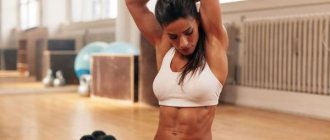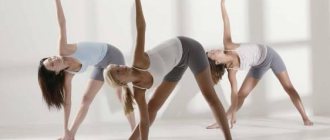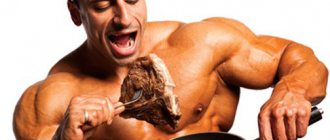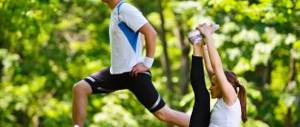Warm-up before starting a workout is a set of exercises that prepares the body for intense physical activity. With its help, you will halve the risk of sports injuries and increase the benefits of exercise. Duration – 5-15 minutes.
Warm-up can be general or specific. General – aerobic exercise. Its goal is to saturate the muscles with oxygen. With the help of a general aerobic warm-up, they increase muscle tone, warm up tendons and ligaments, speed up the heart rate, and slightly increase blood pressure. General warm-up options include jogging, jumping rope, cycling or an exercise bike.
Strength anaerobic warm-up prepares a specific group of muscles and joints for exercise with heavy sports equipment. It helps to feel the work of the muscles, improves its blood supply, and provides mild preliminary fatigue.
Content
- Benefits of warming up: Warming up the joint-ligamentous apparatus
- Warming up the muscles
- Cardiovascular preparation
- Smooth increase in body temperature
- Mental preparation
- Joint gymnastics
When results appear
For amateurs, 100 squats a day is enough. If a person is not able to do that much, he should start with 20 and increase the number by 5-10 repetitions every day until he gets to 100.
You can't force yourself to do more squats when your body starts to struggle. Excessively intense training at the very beginning can cause severe muscle pain, discourage you from training further, and even lead to injury.
Before starting your workout, be sure to warm up. If a person forgets to warm up, the next day he will experience soreness. It is important to remember: the key to success is regularity, without which all efforts will be wasted. The first effects of the exercise are noticeable after 3 weeks.
Source
The benefits of warming up
Warming up the articular-ligamentous apparatus
Against the background of the average daily activity of a metropolis resident, the ligaments lose their elasticity. If they are not pre-warmed, the risk of sprains and tears during exercise increases.
Warming up before exercise increases the production of synovial fluid, which acts as an intra-articular lubricant, which increases joint mobility. Without it, the risk of arthrosis and arthritis increases in the medium term.
Warming up the muscles
“Cold” muscles are susceptible to spasms and cramps, sprains, tears and tears. On the contrary, warmed muscles contract and relax better, so the athlete’s strength capabilities increase.
Saturating your muscles with oxygen and nutrients also increases endurance during exercise. In addition, to form an attractive body shape and gain muscle mass, neuromuscular connections are needed, which are triggered during warm-up.
Cardiovascular preparation
At rest, the heart rate of an adult is 60-80 beats per minute. During physical activity it increases to 140-170. Without warming up, your internal “engine” figuratively switches from 1st automatic gear directly to 5th. Because of this, hypertrophy of the heart muscle gradually develops - “sports heart” syndrome.
It is often accompanied by functional cardiac disorders - irregular heart rhythm, rapid pulse, increased blood pressure. In order not to provoke the listed conditions, the heart rate should increase gradually - during the warm-up before training.
Smooth increase in body temperature
Normally, during physical activity, body temperature rises. Warming up triggers the natural process of thermoregulation, so your well-being does not deteriorate during the workout. Experts recommend training until light sweat appears on the forehead - this is a sign that the body is ready for more intense exercise.
Mental preparation
Psychology is an important component of the training and competitive process. Understanding that you are doing everything correctly, controlling muscle load, working according to plan, mentally sets you up for maximum results. At the same time, motivation increases, and training becomes more productive.
In addition, during warm-up, the synthesis of hormones responsible for energy production is activated, coordination of movements and attention are increased.
Why is it dangerous not to warm up before an intense workout?
Exercising without warming up increases the risk of sprains, muscle strains, or joint injuries. They are followed by breaks in classes, that is, a stop in sports progress and a rollback of existing results. If you do not systematically warm up, this harms the heart muscle (in some cases, sudden surges in pressure and even fainting are possible).
In addition, the unpreparedness of the body's systems for intense training loads produces rapid fatigue and loss of enthusiasm during exercise. Ignoring the warm-up is a typical mistake of beginners who do not want to waste time and, as a result, often get injured in their first classes.
Warm-up plan before working out in the gym
Joint gymnastics
Rotational movements, turns and/or bends in each direction, starting from the neck and ending with the ankle joint. When stretching your neck, avoid rotation, as this part of the spine is extremely vulnerable and any axial loads are potentially dangerous.
Tilt your head to the sides, forward, and gently back (the chin reaches toward the ceiling). After this, carefully knead the rotator cuff of the shoulder joint - to do this, swing in different planes - to the sides, back, up.
Then perform rotational movements in one direction and the other in:
- shoulder joints;
- elbows;
- brushes;
- lumbar spine (if axial loads are contraindicated, replace rotations with tilts);
- hip joints;
- knee;
- ankle.
Do 10-15 repetitions at an average pace. The time for performing joint warm-up before training is 2-3 minutes.
Stretching
Dynamic stretching exercises for all muscle groups mobilize muscle tissue, stretch fascia, stimulate the flow of oxygen to muscle cells, and prepare muscles for power load. The complex is carried out on a top-down basis. Pay special attention to large muscle groups - pectoral muscles, latissimus dorsi, spinal extensors, hip adductors and hamstrings. At the points of maximum tension, it is enough to linger for 5-10 seconds.
Hanging on a bar is suitable for stretching all muscles. To stretch your pectoral muscles, place one hand on a squat rack and lean your whole body forward or spread your arms out to the sides and back as far as possible. To stretch your lower back and hamstrings, do a straight-legged forward bend or hyperextension. Lunges are suitable for stretching the leg muscles.
When performing stretching exercises, you should feel muscle tension, but not pain or discomfort. The complex execution time is 2-3 minutes.
Cardio
Cardio warm-up prepares the cardiovascular system for physical activity. Perform light aerobic exercise with a heart rate of 130 beats per minute. This speeds up metabolism and triggers the processes of lipolysis - the oxidation of adipose tissue.
Cardio warm-up options include walking on a treadmill, elliptical or stepper, walking with high knees, arms and legs. The duration of the complex is up to 5 minutes. Finish when you feel that your body temperature has increased slightly.
Life hack: start your cardio warm-up wearing relatively warm sportswear, such as a sweatshirt, and when you warm up, take it off.
Strength warm-up
For the strength phase of the warm-up, experts recommend CrossFit exercises with minimal weights - no more than 20-30% of the workload. Pay special attention to the muscle group you are training today.
For example, on shoulder day do straight arm swings with ~4 kg dumbbells, on arm day do curls with dumbbells, on chest day do wall push-ups, on leg day do 3 sets of squats. You can perform exercises from the main workout, but in a simplified technique. When performing a strength warm-up, it is important to isolate each muscle group and load it specifically. Therefore, choose isolated exercises, and not, for example, deadlifts.
Options for strength exercises to warm up before training (do it selectively):
- Neck – bend the neck while lying down with a disc on the back of the head or on the forehead. 2 sets of 20 reps.
- Shoulders – standing, swinging dumbbells to the sides or in front of you//barbell row with a wide grip to the chin. 2 sets of 25 reps.
- Chest – push-ups//crossover crossover. 3 sets of 20 reps.
- Back – hyperextension//upper side row with wide grip//pull-ups with wide grip. 2 sets of 15 reps.
- Arms – lifting from the lower block with an EZ-handle to the biceps//extension of the arms from the upper block with a rope handle. 3 sets of 20 reps.
- Press crunches while sitting in a machine. 2 sets of 25 reps.
- Legs – squats with your own weight // leg abduction, sitting in a machine // leg curls, sitting in a machine // leg extensions, sitting in a machine. 3 sets of 20 reps.
The duration of the strength warm-up complex is no more than 5 minutes.
What is joint gymnastics?
If after physical activity the ligaments have lost their flexibility and your knees hurt, you need to do a set of therapeutic exercises. Joint exercises help.
This is a set of exercises that strengthens the muscles of the thighs and lower legs, relieves stiffness and pain in the legs, prevents premature wear of cartilage, and stimulates the production of joint fluid and lubrication. Gymnastics gives a positive effect if done systematically. The risk of injury is sharply reduced and intermuscular coordination improves. There are no heavy loads, but such gymnastics gives an impulse to the whole body.
On topic: Planning bodybuilding workouts
The exercises do not require special preparation: you just need a fitness mat and your desire.
When doing joint gymnastics, it is important to do exercises from top to bottom, that is, to work the body consistently. Those who engage in wrestling need to pay special attention to the cervical spine and the joints of the upper shoulder girdle. For boxers - the joints of the hand and metacarpophalangeal joints, for taekwondo fighters - the shin and toe joints.
All exercises should be done smoothly, without sudden movements. Breathing is even and calm.
Warm up before training at home
You can exclude cardio exercises from warming up before training at home, since home exercises are not as intense as in the gym and increase the heart rate slightly. If desired, the treadmill can be replaced by running in place or “shadow boxing” - an imitation of boxing sparring with an imaginary opponent.
Cardio warm-up can be replaced with exercises for the whole body, such as jumpingjack - jumping while clapping overhead, or squats and throwing a ball at the wall. If home workout time is limited, joint exercises and stretching are sufficient.
Types of squats for a beautiful figure
The following exercises will help you diversify the classic squat and use more muscles.
- Squats with a ball. Hold the ball in your hands, squeeze it slightly and extend your arms. Stand on your toes and do a squat, pressing your heels firmly to the floor and making sure that your knees do not go beyond the line of your feet. Then straighten up and stand on your toes again, squeezing your buttocks.
- Squats with a rise. Place two dumbbells on the floor. Do squats, grab dumbbells and straighten up, tightening your buttocks and lengthening your shoulders. Do a series of these squats, remembering to keep your back straight.
- "Ballet" squats. Standing with your back straight, place your feet wider than your arms. Your toes should point outward. Lower your body by bending your knees. Having reached the lowest position, quickly return to the original position. Lower your body one more time and raise it again.
- Squats with folded legs. This type of squat is the complete opposite of its previous version. The legs are connected together throughout the entire exercise. The technique is very simple: stand up, lower your body, bend your knees and throw your buttocks back. The knees should not extend in front of the toes.
- Squats with legs spread and legs folded. Place your feet shoulder-width apart. Slowly lower your torso and lift it up. Next time, bring your legs together and lower your torso a little, then quickly lift up.
- Jump squats. This type of squat starts out identical to the main one. When lifting your body, you need to jump and straighten your knees. You can hold your hands behind or above your head to help maintain balance.
- Triple squats. Bend your knees as much as possible. With your torso down, extend your arms forward and make three quick movements, raising and lowering your buttocks.











